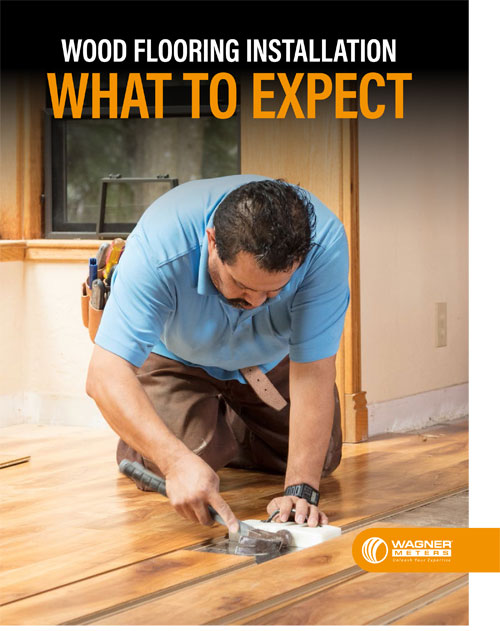Should You Install Flooring on Wet Concrete When the GC Says So?
This article is a reprint from the October 2016 issue of Concrete Construction.
A general contractor (GC) and flooring installer at a construction site were at a crossroads. After doing their due diligence by performing a relative humidity (RH) test on the concrete, which involved inserting a RH probe to a depth of 40 percent in the slab, the results indicated the concrete floor was too wet. More time was needed for the concrete to dry before the flooring could be safely installed.
The RH test they used was a smart choice. It provided a fast, reliable, and scientifically proven method for determining the actual moisture condition inside the concrete. Why test from the inside? Concrete surface tests, such as the calcium chloride test, are inadequate because slabs invariably exhibit a moisture gradient prior to being sealed by a floor installation or coating. In addition, the surface layer is more vulnerable to ambient temperature as well as the RH of the room.
Concrete drying times vary, although a typical rule of thumb is to allow at least 28 days for each inch in the concrete slab. Many other factors influence drying time as well, such as the way the concrete was mixed and surface preparation.
Given the concrete’s moisture condition, the GC faced a dilemma. He could ignore the problem and go ahead with the flooring installation. He could utilize a moisture mitigation system on top of the concrete prior to starting the flooring installation, adding additional cost to the project. Or he could continue RH testing until the readings were below the acceptable RH% threshold of the floor manufacturer’s specifications, which could potentially cause a significant delay in the project.
The GC was keen to proceed in order to stay on schedule. However, the flooring installer had installed hundreds of floors and he knew the risks. He told the GC that he understood why he believed the project needed to keep moving, that time and money, not to mention business reputations, were on the line.

Excess moisture in concrete can lead to expensive repairs
The flooring installer also emphasized that over $1 billion in damages occur every year due to excess moisture in concrete slabs. He had seen his fair share of floors that had warped, blistered, peeled, de-bonded, etc. And he knew that if the project went ahead, everyone, including the building owner, could be liable for damages which would cost much more than any delay now.
Knowing all this, the flooring installer insisted that the installation of the floor wait until the slab was sufficiently dry.
If we take a look back, we can review some steps that could have been taken to ensure the concrete dried more quickly. But even before thinking about specific methods for speeding up the concrete drying process, first, and most importantly, is the need to plan ahead, to be realistic about the time needed for the concrete to dry, and to build adequate time into the project for concrete RH testing.
Some important considerations in the early planning stages include:
- enclosing the structure as soon as possible after the concrete has been poured to control variable ambient temperatures and keep the air circulating with HVAC
- finishing techniques used should allow the surface to be kept open while the concrete slab dries; hard troweling can seal off the natural capillaries that allow moisture to move through the slab
- choosing the most appropriate flooring products for the construction schedule
- along with these important procedures, potential mitigation measures must be factored into the project budget
These steps are as vital as any for ensuring project success. Here are other possible steps to consider:
Pre-pour examples:
- maintaining a low water to cement ratio; most recommend .50 or less
- installing subgrade vapor barriers below the concrete can stop the flow of moisture from the soil
Post-pour examples:
- dehumidifying methods can also help remove moisture in the air, for example, desiccant-based dehumidifiers hold and bind humid air
- increasing airflow across the concrete surface to help move the evaporating moisture into the air
- increasing temperature in the fully enclosed environment to help expedite moisture moving out of the slab

Free Download – Wood Flooring Installation: What To Expect
In an ideal scenario, letting concrete dry naturally is usually best, but construction project schedules often don’t allow enough time for this important process. Each floor installation has a unique set of variables, and RH testing is an absolute must for obtaining an accurate assessment of the slab’s moisture condition. Plus extensive pre and post-pouring planning is vital in preparing for and mitigating problems.
Fortunately, in this story, the flooring installer’s strong recommendation was taken. The GC agreed to delay the floor installation until the concrete’s moisture condition met the flooring product manufacturer’s specifications. This helped the team avoid costly financial and legal implications of a failed flooring installation.
Jason has 20+ years’ experience in sales and sales management in a spectrum of industries and has successfully launched a variety of products to the market, including the original Rapid RH® concrete moisture tests. He currently works with Wagner Meters as our Rapid RH® product sales manager.
Related Posts via Taxonomies
Last updated on August 24th, 2021





Hi JAson ,
We have a basement room in a house built in the 70s . It flooded once after we underwent foundation injections to stop movement and cracking in one area of the house. Unfortunately the contractor injected most of the inhibitor into an agriculture pipe to allow water to escape. After the flood we dug the whole side of the house up to foundation level and reinstalled new pipes and water proofing to the external wall to regulation standards . We left the inside of our basement room unfinished for about a year to make sure all weather conditions were not going to adversely affect the room again. We still aren’t sure what floor covering to use over the concrete slab. Our concern is that there still maybe water escaping from cement pad although it is not visible and it is not really enough to give a concerning reading of water moisture . We have explore a number of options for a floor surface but there are concerns for each option. 1. It is a very uneven surface as the person who originally laid the slab was the owner builder so concrete polishing is not an option . 2. Waterproofing the cement pad . Does this cause issues if there is still water vaporising through the pad.? Some contractors have suggested this to us but we are still not convinced that this would be the best solution as it might cause damage over time to the existing pad . Is this an issue?
Heather:
Thanks for the questions. Be cautious when looking at waterproofing systems. Waterproofing and vapor proofing are two different things and vapor proofing is what you are trying to do when looking to minimize moisture from impacting a floor finish. As far as a moisture mitigation system (this is what they are called) causing problems long term, that’s really not a worry. The concrete loves the moisture, but the finishes don’t so the mitigation products help lessen the amount of moisture that comes in contact with the floor, helping ensure the floor lasts. Good luck.
Hi, thanks for the info. We have just had wet concrete installed but it is then being battened with insulation before the oak floor goes in. The oak floor is also going to be treated. Would this be sufficient due to the air flow under the floor for the moisture, or would it still cause damage? Really don’t want to wait a month for the floor to dry! Thanks
Rich
Rich:
Thanks for the question. I am going to say I’m not all that familiar with the installation practice you are describing here. The comments I am going to make assume the floor is an interior application. That being said, moisture will still have to go somewhere so my question(s) would be: is the insulation permeable and if so, what is going to keep it from allowing the moisture to interacting with the wood and causing issues with cupping? With the excess moisture in the insulation, what is going to keep mold from growing? FYI, as a rule of thumb, a slab will take 30 days, for every one inch of slab thickness, to dry to an acceptable level for most finished to be installed, once the ambient environment is conducive for drying. (consistent, reasonable temperature and low relative humidity). The “30-day rule” relates to compressive strength of the concrete, not drying.
Interesting, thanks for the info!
Jason, Are RH in concrete slab measurements impacted by the presence of an installed floor? Also when measurements collected vary by as much as 20% RH from one to another, should the measurements be averaged?
John:
Thanks for the question. As long as you start measuring the proper depth of your hole AFTER the thickness of the finished floor product, then you are fine. An example is 6” concrete (slab on grade) with ½” solid wood installed on top. 40% of 6” is 2.4”, so you would need to be 2.4” into the slab. If I drilled the hole and measured from the bottom to the top of the finished ½” wood, then the measurement would be roughly (I am not including potential adhesive thickness) 2.9” overall.
Answering your second question, in my experience, you very seldom see a legitimate 20% variance on the same job. I would have to question the abnormal readings. In any event, you wouldn’t average readings.
Thanks,
Jason
There is a thing in the industry called “the shaw letter” it was made by shaw to install over wet concrete. Basically a liability waver. Installers should ask around. It is very helpful. Once presented I’ve never seen an owner/architect/gc all sign off.